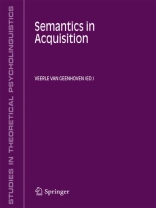A good deal of work in language acquisition has been devoted to children’s interpretation of sentences that contain the universal quantifier, e. g. , every in English. It has been observed in several experimental studies and across several languages that some school-age children experience difficulty in interpreting such sentences (e. g. , Inhelder & Piaget, 1964; Roeper & de Villiers, 1991; Philip, 1995). Non-adult responses from children have been found in various conditions, including the circumstance exemplified in the picture in Figure 1, where three boys are each riding an elephant and a fourth elephant (referred to as the ‘extra-object’) is not being ridden. Some children who are shown such a picture sometimes respond No to the question in (1) relative to this picture: (1) Is every boy riding an elephant? Figure 1. The Extra-Object Condition To justify their negative answer to the question in (1), children often point to the extra object, i. e. , the elephant that is not being ridden. This reply has been called the symmetrical response or the exhaustive pairing response since children who give this kind of response seem to interpret the question to be about the symmetry (i. e. , one-to-one relation) between the set of entities denoted by the subject noun (the boys) and the set denoted by the object noun (the elephants).
Tabela de Conteúdo
The development of the syntax-semantics interface.- ‘Mismatches’ of Form and Interpretation.- Watching Noun Phrases Emerge: Seeking Compositionality.- Cross-Linguistic Acquisition of Complement Tense.- Acquiring Universal Quantification.- Everybody Knows.- The Effect of Context on Children’S Interpretations of Universally Quantified Sentences.- Structure and Meaning in the Acquisition of Scope.- Time in the language of a learner.- Time for Children: An Integrated Stage Model of Aspect and Tense.- State Change and Temporal Reference in Inuktitut Child Language.- Temporal Adverbials and Early Tense and Aspect Markers in the Acquisition of Dutch.- Finiteness and its development.- On Finiteness.- Functions of Finiteness in Child Language.- Focus particles in child language.- Additive Particles and Scope Marking in Child German.- (Un)Stressed ook in Child Dutch.Sobre o autor
Veerle Van Geenhoven is a formal semanticist with a primary interest in crosslinguistic research. She received a ‘Dr.phil.’ degree in linguistics from the Eberhard-Karls-Universität Tübingen, Germany, in 1996, and a university lecturing qualification (Habilitation) from the Johann-Wolfgang-Goethe-Universität Frankfurt, Germany, in 2005. She held positions at the University of Stuttgart, the Max Planck Institute for Psycholinguistics in Nijmegen, the University of Bielefeld, UC Santa Cruz, and the Radboud University in Nijjmegen. In the last years, her research has been made possible by a fellowship of the Royal Netherlands Academy of Arts and Sciences.
Língua Inglês ● Formato PDF ● Páginas 355 ● ISBN 9781402044854 ● Tamanho do arquivo 2.3 MB ● Editor Veerle van Geenhoven ● Editora Springer Netherland ● Cidade Dordrecht ● País NL ● Publicado 2006 ● Carregável 24 meses ● Moeda EUR ● ID 2147600 ● Proteção contra cópia DRM social












